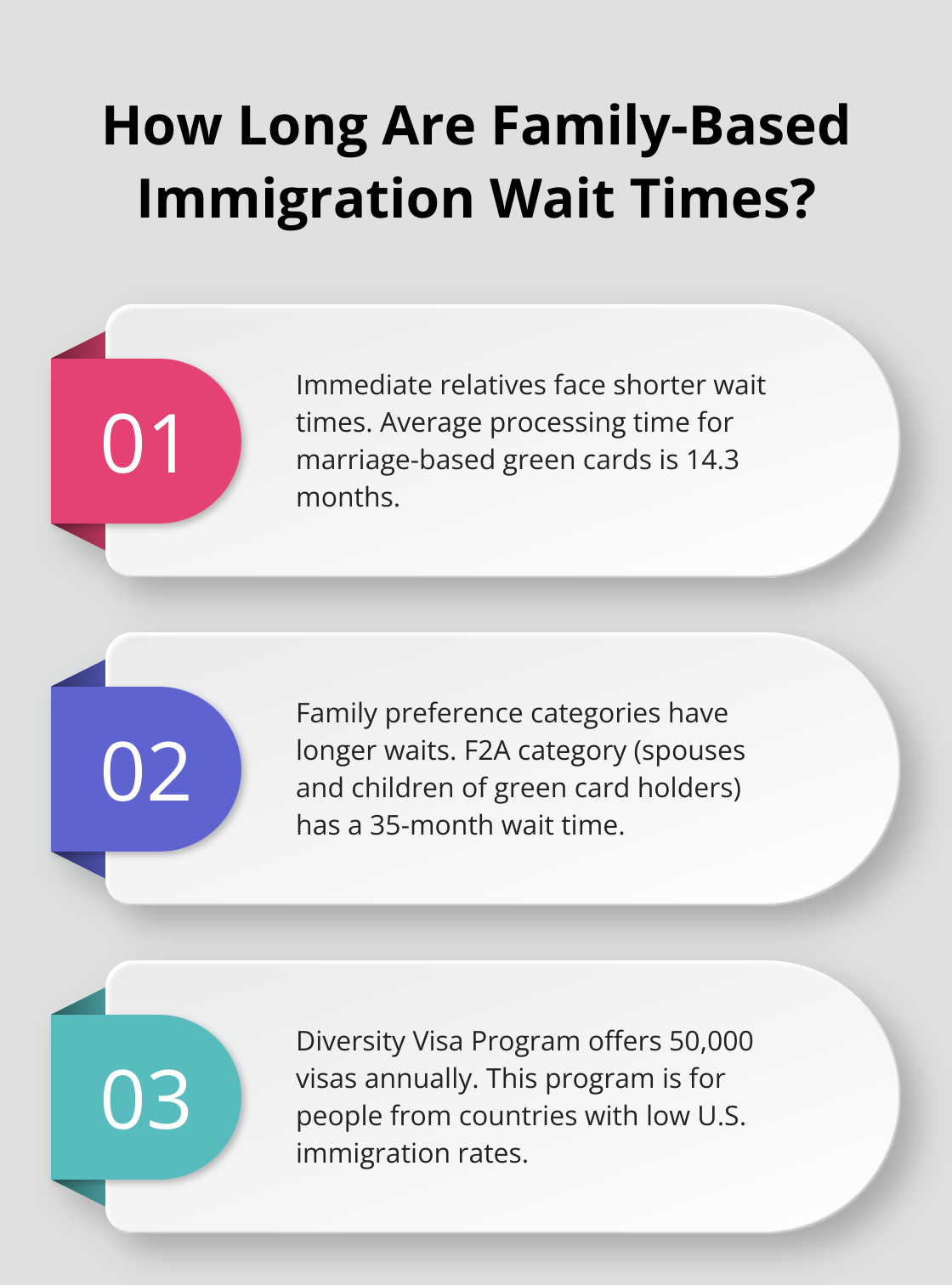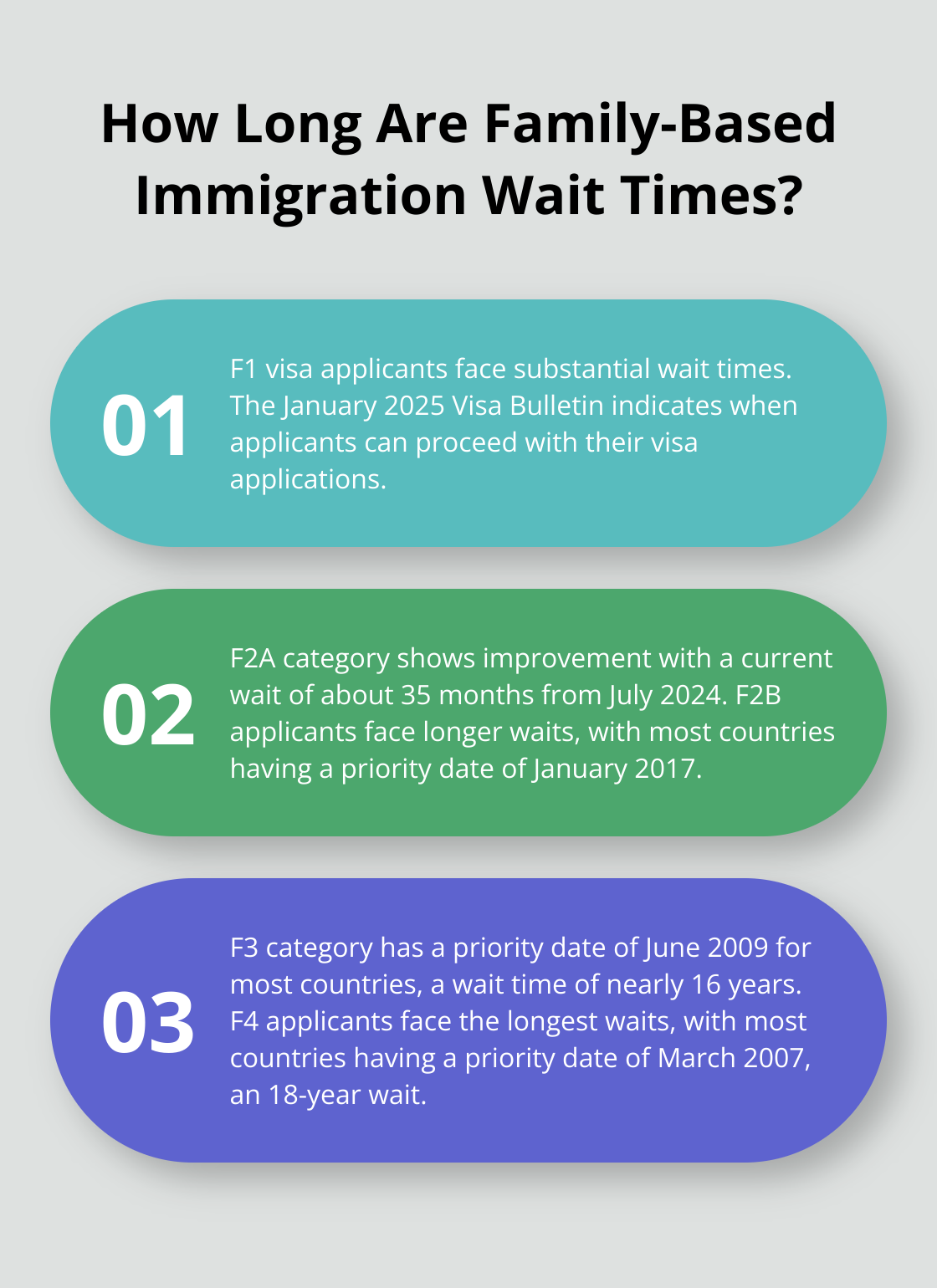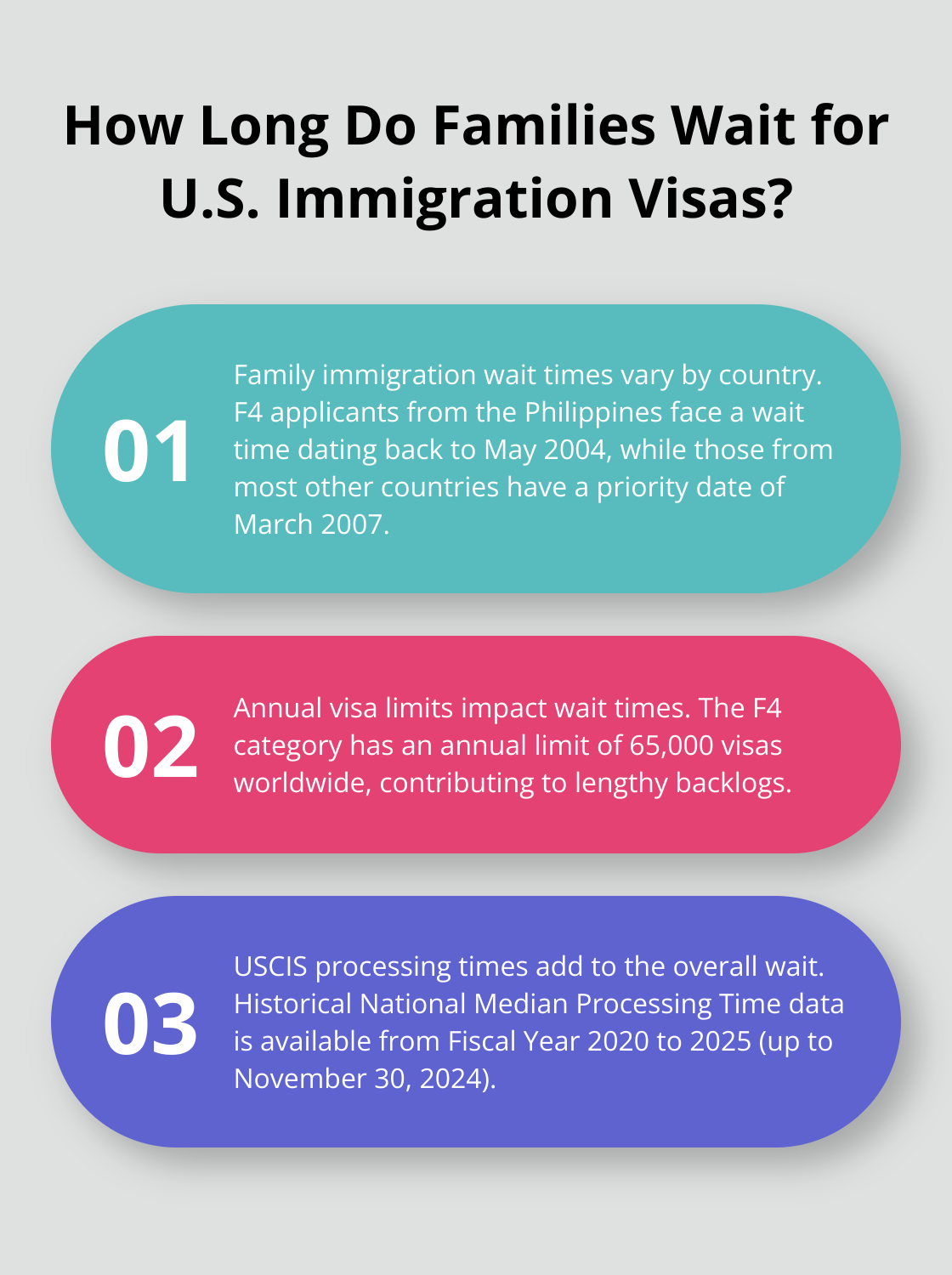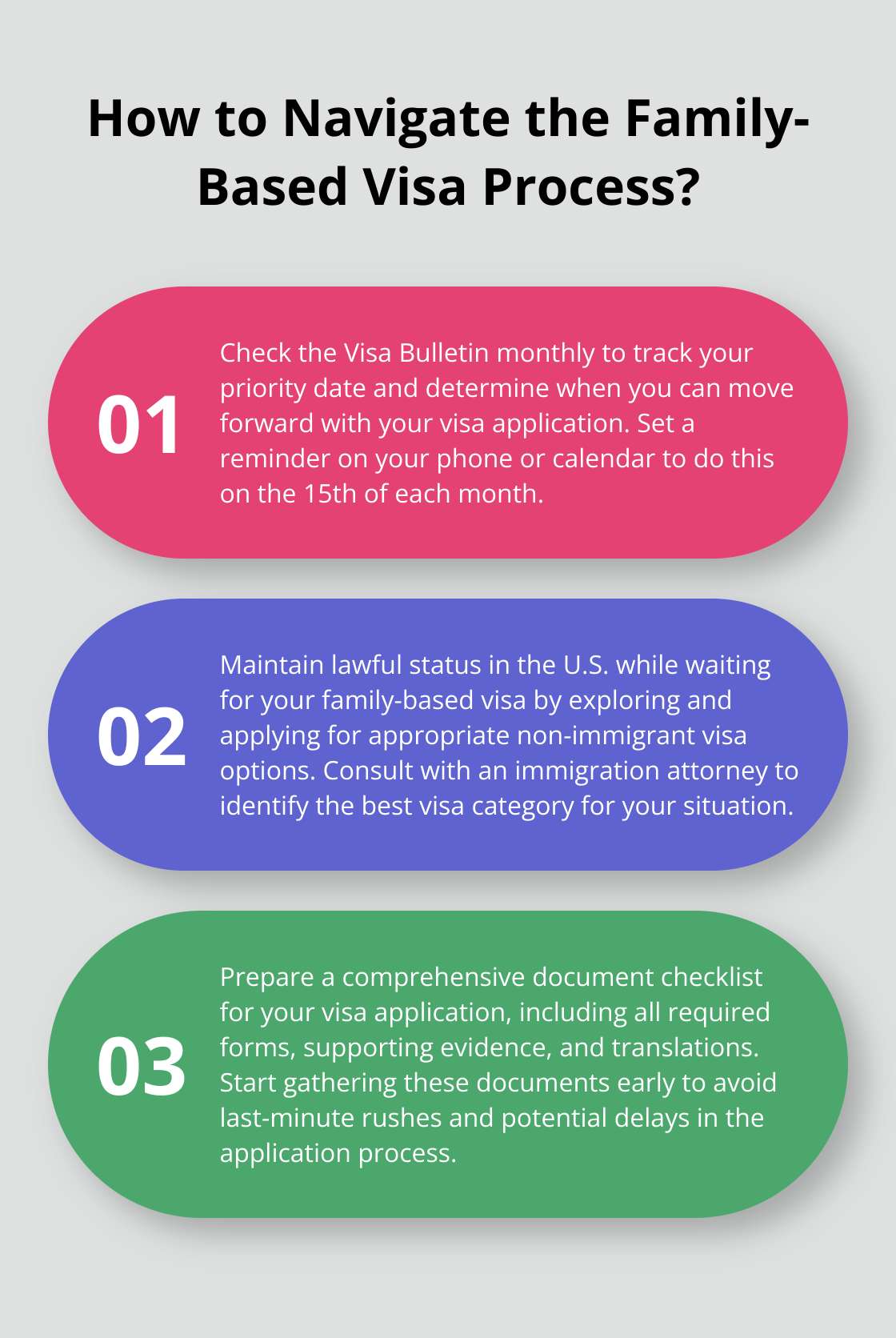
US Family Immigration: Current Wait Time Analysis
Family-based immigration is a cornerstone of the U.S. immigration system, but understanding the process can be challenging. At Law Offices of Jeffrey A. Thompson, we often field questions about US family immigration wait times.
This blog post breaks down the current wait times for various family-based immigration categories and explores the factors that influence these timelines. We’ll provide you with up-to-date information to help you navigate this complex process more effectively.
Family-Based Immigration Categories: A Comprehensive Overview
Family-based immigration forms a cornerstone of the U.S. immigration system. This complex system includes several distinct categories, each with its own set of rules, eligibility criteria, and processing times. Understanding these categories proves essential for anyone considering immigration to the United States through family ties.
Immediate Relatives of U.S. Citizens
The most direct path to family-based immigration exists through immediate relative status. This category includes:
- Spouses of U.S. citizens
- Unmarried children (under 21) of U.S. citizens
- Parents of U.S. citizens (who are at least 21 years old)

Immediate relatives enjoy a significant advantage: no annual cap limits the number of available visas, which typically results in shorter wait times. Recent USCIS data shows the average processing time for a marriage-based green card (I-130) filed by a U.S. citizen sponsor stands at 14.3 months. This marks a notable improvement from previous years, reflecting USCIS efforts to streamline the process.
Family Preference Categories
For family members who don’t qualify as immediate relatives, the family preference system applies. This system divides into four categories:
- F1: Unmarried sons and daughters of U.S. citizens (21 years or older)
- F2A: Spouses and unmarried children (under 21) of permanent residents
- F2B: Unmarried sons and daughters (21 or older) of permanent residents
- F3: Married sons and daughters of U.S. citizens
- F4: Brothers and sisters of adult U.S. citizens
Each of these categories has an annual numerical limit, which can lead to significant waiting periods. For example, as of July 2024, the wait time for the F2A category (spouses and children of green card holders) reaches approximately 35 months.
Diversity Visa Program
While not strictly a family-based category, the Diversity Visa Program (also known as the green card lottery) warrants mention. This program makes 50,000 immigrant visas available annually to people from countries with low rates of immigration to the United States. It offers a unique opportunity for those who may lack family ties but wish to immigrate.
Special Immigrant Categories
Special immigrant categories can also lead to family-based immigration. These include:
- Certain religious workers
- Employees of U.S. foreign service posts
- Retired employees of international organizations
While these categories occur less frequently, they provide important pathways for specific individuals.
The intricacies of these categories significantly impact the immigration journey. For instance, a client navigating the F2B category might reduce their wait time by ensuring meticulous preparation and submission of all required documentation (a process that experienced immigration attorneys can facilitate).
As we move forward, let’s examine the current wait times for these various family-based immigration categories in more detail. This information will provide a clearer picture of what to expect when embarking on the family-based immigration process.
Current Wait Times for Family-Based Immigration
Family-based immigration wait times differ significantly across preference categories. This section examines the current wait times for each category based on the latest data from the U.S. Department of State and USCIS.
F1: Unmarried Sons and Daughters of U.S. Citizens
F1 visa applicants face substantial wait times. The January 2025 Visa Bulletin summarizes the availability of immigrant numbers, indicating when applicants can move forward with their visa applications.
F2A: Spouses and Children of Permanent Residents
The F2A category has seen improvements. Current processing times indicate a wait of approximately 35 months from July 2024. This reduction from previous years offers hope to families separated by immigration processes.
F2B: Unmarried Sons and Daughters of Permanent Residents
F2B applicants face longer waits. Most countries have a priority date of January 2017 (about an 8-year wait). Mexican applicants encounter extended delays, with current processing reaching back to July 2001.
F3: Married Sons and Daughters of U.S. Citizens
The F3 category currently shows a priority date of June 2009 for most countries (a wait time of nearly 16 years).
F4: Brothers and Sisters of Adult U.S. Citizens
F4 applicants (siblings of U.S. citizens) face the longest waits. Most countries have a priority date of March 2007 (an 18-year wait).

These wait times fluctuate based on various factors, including changes in immigration policies and application volumes. Strategies exist to potentially expedite the process. Maintaining a valid non-immigrant status while waiting or exploring alternative visa categories can prove beneficial.
The immigration system’s complexity requires expert guidance to ensure correct filing of all documentation and meeting of deadlines. This attention to detail can prevent unnecessary delays in an already lengthy process.
Understanding these timelines forms just the first step in the immigration journey. The next section will explore the factors that influence these wait times, providing a deeper understanding of the family-based immigration process.
What Influences Family Immigration Wait Times?
Country of Chargeability
The country of chargeability (typically the applicant’s country of birth) significantly affects wait times. Countries with high immigration rates to the U.S., such as Mexico, India, China, and the Philippines, often face longer waits due to per-country visa limits. These caps create decades-long backlogs, making the immigration system less efficient and less fair. For example, as of January 2025, F4 applicants (siblings of U.S. citizens) from the Philippines face a wait time dating back to May 2004, while those from most other countries have a priority date of March 2007.
Annual Visa Limits and Demand
The Immigration and Nationality Act sets annual limits on the number of visas available for each family preference category. When demand exceeds these limits (which often happens), backlogs form. The F4 category, for instance, has an annual limit of 65,000 visas worldwide. This cap, combined with high demand, results in the lengthy wait times we observe today.
USCIS Processing Times
USCIS processing times add another layer to the wait. Historical National Median Processing Time for All USCIS Offices for Select Forms By Fiscal Year is available from Fiscal Year 2020 to 2025 (up to November 30, 2024). However, this represents just the first step. After I-130 approval, applicants must wait for visa availability based on their priority date and category.
Strategies to Navigate Wait Times
While these factors can lead to long waits, several strategies might expedite the process:
- Consider alternative visa categories: Applicants may qualify for multiple categories. Exploring all options can lead to faster processing.
- Maintain lawful status: For those already in the U.S., maintaining valid non-immigrant status while waiting can prevent complications.
- Stay informed: Regular checks of the Visa Bulletin and USCIS processing times can help in planning and decision-making.
- Seek professional guidance: Immigration law is complex and ever-changing. Working with an experienced immigration attorney (such as those at Law Offices of Jeffrey A. Thompson) can help navigate the process more efficiently and avoid pitfalls that could lead to further delays.
Impact of Documentation Preparation
Meticulous preparation of documentation can help avoid unnecessary delays in USCIS processing. Ensuring all forms are filled out correctly and supporting evidence is comprehensive can make a significant difference. This attention to detail (which experienced immigration attorneys can provide) often proves invaluable in streamlining the process.

Final Thoughts
US family immigration wait times present a complex challenge for many individuals and families. The duration varies significantly across different categories, influenced by factors such as country of origin, annual visa limits, and processing backlogs. Immediate relatives of US citizens typically face shorter wait times, while those in family preference categories may encounter longer delays.

The intricacies of the immigration system highlight the value of professional guidance. An experienced immigration attorney can provide essential assistance in navigating these complexities, ensuring accurate documentation, and exploring available options to potentially expedite the process. They can help you understand the nuances of your specific situation and develop strategies to navigate the waiting period effectively.
At Law Offices of Jeffrey A. Thompson, we specialize in guiding clients through the intricate process of family-based immigration. Our team understands the emotional and practical challenges that come with long wait times and separation from loved ones. We provide expert assistance in preparing and filing immigration petitions, ensuring all documentation is complete and accurate to avoid unnecessary delays.


